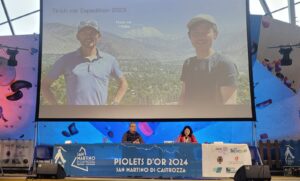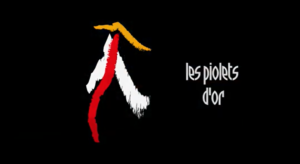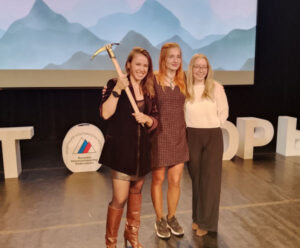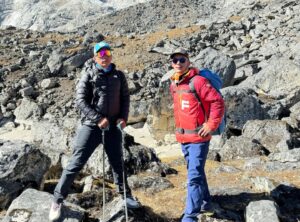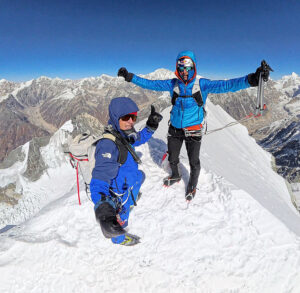Peter Hamor didn’t have a rewarding experience on Kangchenjunga in 2022. He failed to reach the summit and was appalled by the extreme commercialization of the mountain. Choppers flew to higher camps, there were long queues of climbers, and almost everyone used bottled oxygen.
Hamor thought back to the last time he had been on Kangchenjunga. Then, a bunch of climbers from several countries cooperated to fix ropes on the most exposed passages and worked together to break the trail.
“Back then, meeting someone on an 8,000’er summit was an extraordinary coincidence,” Hamor said.
And so, on Kanchenjunga, Hamor decided he was done with the 8,000’ers. He would find lower but more gratifying peaks to climb with friends. But who? Hamor had two people in mind: Italians Romano Benet and Nives Meroi.

The team in Nepal. Left to right, Hamor, Benet, Meroi, and newcomer Boyan Jan. Photo: Benet/Meroi
The team
Hamor had met Meroi and Benet on Kangchenjunga in 2012. The Italians had good memories of Kangchenjunga in 2012, even though Hamor, who climbed ahead of them, took the right way to the main summit (there were no ropes at the time) and the couple mistakenly reached a secondary summit. The Italians returned two years later and made the main summit, but by then, things were evolving in a way they didn’t like.
During the 2022 Kanchenjunga expedition, 7,000m Kabru South drew Hamor’s eye. He started formulating a plan for the following spring and called Meroi and Benet.
“We have known each other for many years and all shared the same goal: to find nice climbs and solitude in peaks isolated from the crowds,” Hamor said. “We just wanted to be in the mountains, find our way up beautiful peaks in a laid-back, easy style,” he said.
“After years without traveling to the Himalaya, we finally found something we wanted to do,” the Italians added.

Left to right, Peter Hamor, Nives Meroi, and Boyan Jan. Photo: Romano Benet
They rounded out the team with a newbie, Boyan Jan, on his first Himalayan trip. “He was the kid in the team, only 51 years old,” Nives joked.
The goal
Kabru South (also known as Kabru IV), located 10km south of Kangchenjunga, is the southernmost 7,000m peak in the world. It had been summited once, by an Indian team, but the peak’s west face remained unclimbed. A Serbian team attempted its 2,800m wall in 2004 but didn’t get far.
“The route, while not technically very difficult, is complex to navigate. This gave the feat an exploratory angle that we liked,” Benet said. “We heard the heli-taxis coming and going to Kangchenjunga, but otherwise we were completely alone. That was special,” Meroi added.

Kabru South along the way to Kangchenjunga’s north side Base Camp. Photo: Peter Hamor
The plan
The mountain is protected by a treacherous icefall between the peak and the Yalung Glacier. The team hoped to avoid it by climbing an adjacent couloir, but conditions made them reconsider.
“We wanted our line to be the most logical, the most direct, and the least threatened by falling rocks and avalanches,” Hamor told ExplorersWeb. “It went almost according to plan, except for the initial couloir. Because of poor ice conditions and constant rockfall, the couloir proved undoable. [Instead,] we had to find our way through a tricky icefall to the left.”

On the icefall. Photo: Nives Meroi/Romano Benet
“We needed a creative eye, the ability to observe the mountain from different angles, to combine perspectives and then, mixing reason and imagination, find the best line. The purest line,” Benet and Meroi wrote in their summit report. “We just started and decided as we went, finding our way pitch by pitch, and there lies the beauty of it,” they told ExplorersWeb.

Video chat with Angela Benavides, carried out in a funny mix of Italian, Spanish, and English.
The climb
The team set off on May 9 at 5:30 am. That night, they slept in tents they had already set up on the route. Surprisingly, they were still standing. Over the following days, they carried the tents and their equipment with them.
On May 10, they climbed the icefall to 5,700m. They scouted a second ice barrier above and placed bamboo wands to mark a potential route. On May 11, they set their tents at 6,200m, rested, and set off for the summit at 4 am, with 1,100m to go.

On steep, hard snow. Photo: Meroi/Benet
The final day took them through a heavily crevassed area and up a steep couloir, 60º to 70º, on hard blue ice and a short rocky outcrop.
“Those last 1,000 vertical meters were harder than expected because of the hard, steep ice and the mixed sections,” Meroi said.
Finally, they reached a balcony and easier terrain to the rocky summit. Hamor made it to the summit of Kabru South at 4:30 pm and the rest of the team followed minutes later.

Benet films his partners on the summit. Photo: Nives Meroi
Lucky spell
Besides the difficult icefall at the beginning, the climb featured several other surprises, most of them pleasant.
“Places that seemed problematic to us from below could always somehow be climbed,” said Hamor. “The route seemed to miraculously open in front of us, even the most tricky sections full of crevasses. In particular, there was an amazing snow bridge across a huge crevasse that permitted us to reach the summit. When we tried to spot the bridge back in base camp, we couldn’t find it.
“There were also some not-so-pleasant moments, such as some falls into crevasses, minor injuries, and frostbite [Jan had some ugly frostbitten toes], but these are the inherent things of Himalayan climbing.”

Photo: Benet/Meroi
“Also, avalanches respected us,” Hamor said, noting that Kabru means “white avalanche.”
The main problem was the weather. The team had to be patient until the team’s meteorologist, Vitor Baia, announced a decent summit window.
Before the window, the team only had time to leave a deposit at 4,700m, then retreat to wait out the bad weather. On May 4, they launched a failed attempt that ended at the top of the serac barrier at 5,600m.
Diamonds on descent
They were also very lucky to find a snow cave at 6,400m on the descent. They had expected to reach their tents, but endless abalakovs took longer than expected and they bivouacked in the cave.
“Also, one of our ropes was damaged and we had to cut it. So our rappels were shorter than normal,” Benet said. “In the end, we found ourselves downclimbing in the night.”
It was pitch-black and extremely cold when they found a cave. They had no sleeping gear but could at least enjoy some shelter.
“It was a magical place,” Meroi said. The ceiling was covered in crystals that shone like diamonds in the light from their headlamps. This led to the name of their route: Diamonds on the soles of her shoes. “We all liked that song by Paul Simon.”

Topo of the route on Kabru South: Diamonds on the soles of her shoes, (IV), D+, 60°. Photo: Peter Hamor
At dawn, they left the cave and downclimbed back to the tents. They rehydrated and rested for the rest of the day and then returned to Ramche village.
Not yet done
Those tempted to think that Kabru South makes for a nice farewell climb for the veteran mountaineers don’t know Hamor, Benet, and Meroi.
“For every mountaineer, reaching the summit by a new route is something special, even more, if it is a first ascent on a virgin Himalayan face,” Hamor said. “I’m glad that I did it with Nives, Roman, and Bojan, and I hope for further similar climbs in the future. I have enough ideas for several climbing lifetimes!”

Benet during the climb. Photo: Peter Hamor
Hamor mentioned the endless possibilities in the Kangchenjunga region and the Eastern Himalaya. He hasn’t forgotten his big unfinished project either: Dhaulagiri’s NW Ridge. Two years ago, he attempted it for the third time, with Romanians Horia Colibasanu and Mariusz Gane. The expedition ended with a close call when an avalanche buried the team while they slept.

Peter Hamor.
Benet and Meroi are also willing to return to the Himalaya, now that they have re-acquainted themselves with the bigger mountains. During the chat with ExplorersWeb, the Italians said they had considered returning to Manaslu to reach the highest point, as long as they could avoid the crowds by climbing a new route.
“The problem is, as usual, money,” they said. The couple owns a sports shop and can only afford to climb during holidays. They are mostly self-funded.
“I still have this dream of opening a new line on an 8,000’er,” Benet said. “Though I am aware we are not getting any younger!”
Conclusion
This year, climbers opened other routes on 6,000’ers and 7,000’ers that were more technical. But this expedition won us over as a declaration of intention from three veteran climbers. We have followed their careers through the years on the world’s 8,000’ers before commercialization, climbing with style and deep mountaineering values. Despite their years, they have proved they are still ingenuous climbers. Finding a virgin 7,000’er and completing it in elegant style with no fixed ropes, camps, or support.

Meroi during the climb. Photo: Peter Hamor

